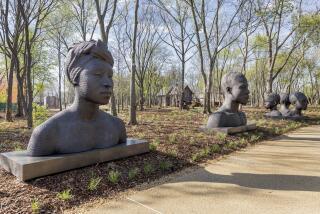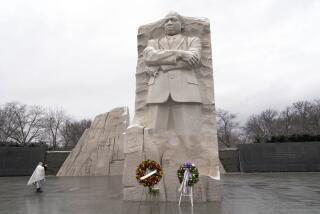America’s story hits home in Memphis, where the National Civil Rights Museum bears witness for all
“This is the story of a people.... It is an American story,” read the sign by the entrance to the National Civil Rights Museum. It’s a tale “of hopes and dreams, of challenge and change.” And the story, the sign concludes, “continues today — with you.” So I already had a lump in my throat as I entered this museum of the American civil rights movement on the site of one of its defining events, the assassination of the Rev. Martin Luther King Jr. on April 4, 1968.
It feels right to tell this story in Memphis, a city that’s always been a crossroads: a key port on the Mississippi River and a hub for shipping, music, food, races and the history that binds them. Although Memphis is different from other crossroads, lacking, for example, the nonstop energy of New York, the dreamers of L.A. or the enveloping charm of New Orleans, the more time I’ve spent in Memphis and relaxed into its pace, music and restaurants, the more it has grown on me.
I first visited in 2012. When I returned last fall I found some welcome changes had been made in those intervening years. Among them, an extensive renovation of the Civil Rights Museum. It opened in 1991, constructed around the Lorraine Motel where King was shot, and reopened in 2014, the 50th anniversary of the passage of the Civil Rights Act.
The latest incarnation kept many of the original highlights and brought the rest into the 21st century, with interactive, multimedia presentations that focus on African Americans’ pursuit of civil rights. The history begins with the transatlantic slave trade, the largest forced migration in history, lasting a shocking 366 years and transporting 121/2 million Africans to the Americas. I felt dehumanized when I learned that one male slave could be purchased for 6 ounces of gold, the equivalent of two muskets, one copper bar or four pieces of linen cloth, only to be transported as cargo in a hold barely 3 feet tall.
The museum covers well-known events such as Rosa Parks’ refusal to give up her seat on a segregated bus, the Montgomery, Ala., bus boycott and the standoff in Selma, Ala., (documented in the movie of the same name), voter registration drives and the black power salute made famous at the 1968 Olympics.
But there were many stories I hadn’t known about, such as the strike in 1968 by African American sanitation workers in Memphis demanding a living wage and safe working conditions as they paraded through the streets holding placards that read “I am a man.”
By the time I reached motel room 306, which is left as it was when King stayed there on that fateful day, it was hard not to choke up.
I’m not African American, but the museum did deliver on its promise of an American story. It poses a lot of questions, with no clear answers, about race, identity, prejudice and how to confront them. And in the months since my visit, especially with the news of the times, I’ve found myself stopped in my tracks every so often, drawn back to that moment and made to think some more.
Indeed the story does continue with me.
::
Eat barbecue like a local in Memphis, plus other restaurants to visit
Barbecue is such an institution here that airlines might just as well include a meal voucher with each plane ticket.
Before my trip last autumn, legions of out-of-towners recommended Rendezvous (52 S. 2nd St.; [901] 523-2746, www.hogsfly.com), a longtime hole in the wall that seems to appear on every TV show about Memphis cooking. But every — and I do mean every — local rolled his eyes, declared it for tourists and steered me elsewhere.
Central Barbecue (147 E. Butler Ave.; [901] 672-7760, www.cbqmemphis.com) was on every local’s list for its dry-rubbed meats slow-smoked over hickory and pecan wood. I visited its downtown location near the National Civil Rights Museum and the South Main Arts District, ordered at the counter, took a number, and before I could take three sips of the local Wiseacre craft beer, a combo plate arrived bearing a couple of days’ worth of food: turkey, pork, ribs and more. Make sure your hotel room has a fridge.
Although Central uses no sauce on its barbecue, the meats were supremely messy. I concluded that any rib joint that provides napkins instead of paper towels should not be taken seriously.
Across town I visited the Bar-B-Q Shop (1782 Madison Ave.; [901] 272-1277, www.dancingpigs.com), a simpler storefront with table and bar-side service, known for its pork ribs and mounds of finely chopped barbecue pork served with Texas toast, baked beans and slaw. Down-home and super-satisfying.
I didn’t expect to find decent seafood in Memphis, 400 miles from the nearest large body of water (the Gulf of Mexico), but Pearl’s Oyster House (299 S. Main St.; [901] 522-9070; www.pearlsoysterhouse.com) showed me. Its specialty is oysters grilled with garlic chipotle butter and Parmesan and simply revelatory, a super start to a lunch of gulf-style seafood butterflied, blackened and bronzed.
For more modern tastes (and more L.A.-like prices) Hog & Hominy (707 W. Brookhaven Circle; [901] 207-7396, www.hogandhominy.com) was worth the drive across town for its Italian-Southern fusion cooking (biscuit gnocchi, creamed corn with Parmesan and tarragon, and the Red Eye pizza topped with pork belly, egg and Fontina cheese). It publishes a cookbook called “Collards & Carbonara” because what else would you call it?
Back toward downtown was Beauty Shop Restaurant (966 S. Cooper St., [901] 272-7111, www.thebeautyshoprestaurant.com) in a renovated — wait for it — beauty shop in the up-and-coming Cooper-Young neighborhood. I settled into a repurposed and quite cushy vintage hairdresser’s chair, blissfully browsed the farm-to-table menu and munched on a grilled romaine salad with heirloom tomatoes, maple-glazed bacon, rosemary spiced pecans and creamy blue cheese dressing, followed by “sugar and spice” crispy duck with grapes, figs and marcona almonds.
::
Memphis gave sound to the soul of America: Here’s where to hear it today
Even before I left for Memphis, the phrase “birthplace of rock ‘n’ roll” had been drummed into my head. I mean — great balls of fire! — dozens of legends, such as Elvis Presley and Otis Redding, Johnny Cash and Isaac Hayes, B.B. King and Al Green, the Staple Singers and Jerry Lee Lewis, recorded here.
My first stop on my music tour was the Blues Hall of Fame (421 S. Main St.; [901] 527-2583, Ext. 14, www.blues.org/hall-of-fame), which opened in May to showcase the history of the blues and its illustrious performers, such as W.C. Handy, Howlin’ Wolf, Bessie Smith and Bonnie Raitt. It’s not a huge space (in the basement of the Blues Foundation), but I got happily lost among the display cases of vintage photos, album covers and costumes. The best part, though: I could have spent hours with the classic recordings at one of the many listening stations. Ruth Brown’s haunting “Break It to Me Gently” got me right in the gut.
Even newer is the Memphis Music Hall of Fame (126 Beale St.; [901] 205-2532, www.memphismusichalloffame.com), which opened late last year steps from the blues clubs of Beale Street. It salutes acts such as B.B. King, ZZ Top and Justin Timberlake and includes artifacts such as King’s autographed guitar, Al Green’s handwritten lyrics to “Take Me to the River” and a cross-section of Jerry Lee Lewis’ 1983 Cadillac.
Then there are the classics. Elvis Presley’s mansion, Graceland (3734 Elvis Presley Blvd.; [800] 238-2000, www.graceland.com, adult tickets from $38.75), is an obligatory stop for any first-timer. About nine miles east of downtown Memphis, it’s been preserved as it was when the King left the building for his eternal home in 1977. I’ll admit to a chill and a thrill as I walked the Greek-columned, shag-carpeted, tiki-splendored, gold-record-festooned, vintage-technology-filled halls.
It’s really a whole Gracelandplex now, with nearby buildings housing exhibits of Elvis’ movies, cars and airplanes — his plane, the Lisa Marie, was refurbished with gold-plated seat belts on its suede chairs and 24-karat gold-flecked sinks. Subtle the man was not, and, I might add, neither are the merchandising opportunities.
Across town, I found Sun Studio (706 Union Ave.; [800] 441-6249, www.sunstudio.com, $12 tour) a lot more low key (pardon the expression) and less commercial. On the guided tour of the studio where Elvis recorded and the legendary jam session of the Million Dollar Quartet (Elvis, Johnny Cash, Carl Perkins and Jerry Lee Lewis) took place, my body tingled as I held the very mike used by the King, while another guest thoughtfully shot my picture.
Not to be outdone, Stax Museum of American Soul Music (926 E. McLemore Ave.; [901] 942-7685, www.staxmuseum.com, $13 admission) explores the genre in the former headquarters of Stax Records (1957-75), record label of Otis Redding, Isaac Hayes, the Staple Singers and Sam & Dave. The museum chronicles soul’s origins with a simple, wooden, turn-of-the-last century reconstructed Mississippi Delta church and follows the genre with a wall of gold records and Hayes’ custom Cadillac Eldorado, the ultimate rock-star car with 24-karat gold trim and white shag on the floorboards.
I also gained a new appreciation of non-Stax acts with soul ties such as Aretha Franklin, Ike and Tina Turner, the Jackson Five, James Brown and Parliament-Funkadelic. Plus, it’s the only museum I’ve visited with a dance floor you can use, a mirror ball and a wall of vintage videos from “Soul Train.” Sorry everyone, that geeky guy was me.
At night, the three-block stretch of Beale Street, in the heart of downtown Memphis, comes alive. It’s where Elvis learned from the masters and, half a century later, it’s still going strong. I happily joined the mix of tourists and locals ducking in and out of Rum Boogie Café (182 Beale St.; www.rumboogie.com) and B.B. King’s Blues Club (143 Beale St.; [901] 524-5464, www.bbkings.com/memphis). Sure, it can get rowdy, but after all, isn’t music about letting go?
If you go
THE BEST WAY TO MEMPHIS, TENN.
FROM LAX, Delta offers nonstop service to Memphis, and American, United, Delta and Southwest offer connecting service (change of planes). Restricted round-trip fares from $320, including taxes and fees.
WHERE TO GO
National Civil Rights Museum, 450 Mulberry St., [901] 521-9699, www.civilrightsmuseum.org
WHERE TO STAY
Peabody Memphis, 149 Union Ave., [901] 529-4000, www.peabodymemphis.com. What the Waldorf Astoria is to New York, the Peabody is to Memphis, a grande dame in the heart of downtown. Its lobby and 464 guest rooms are done up in Old-World style. One thing the Waldorf does not have: daily parades of ducks to the famous fountain in the center of the lobby. Doubles from $219.
Big Cypress Lodge, 1 Bass Pro Drive, [901] 620-4600, www.big-cypress.com. It’s a hunting lodge inside the Pyramid housing the massive Bass Pro Shop. Expect lots of rough-hewn wood and taxidermy. Doubles from $250.
Madison Hotel, 79 Madison Ave.; [901] 333-1200, [866] 446-3674, www.madisonhotelmemphis.com. If the Peabody is traditional and Big Cypress Lodge is country, the Madison is all urban, bold colors with swirls, whirls and touches inspired by the city’s music scene. It’s in a converted 1905 bank building with a gym in the former vault. Doubles from $209.
Hampton Inn & Suites Memphis-Beale St., 175 Peabody Place; [901] 260-4000, www.lat.ms/1KVtGDA. The newest of the bunch, with large-ish rooms at more modest prices; includes a large breakfast. Its proximity to Beale Street’s music venues can be good (close) or bad (noisy if you don’t choose the right room). Doubles from $199.
TO LEARN MORE
Memphis Convention & Visitors Bureau, www.memphistravel.com/our-guide-memphis
More to Read
Sign up for The Wild
We’ll help you find the best places to hike, bike and run, as well as the perfect silent spots for meditation and yoga.
You may occasionally receive promotional content from the Los Angeles Times.






